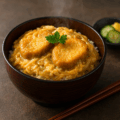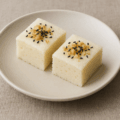いわなの塩焼き(宮城)の特徴
清流の旨みを引き出す、最小限の“塩”で香ばしく焼き上げます
いわなの塩焼きは、内臓をととのえた川魚に下味の塩をふり、串を打って遠火でじっくり焼き上げるシンプルな一品です。皮は香ばしく、身はしっとりふっくらと仕上がり、清らかな香りをたのしめます。
串打ちと“化粧塩”が美しい仕上がりの決め手です
身が反らないようにまっすぐ串を打ち、ヒレ先に化粧塩をのせて焦げを防ぎます。炭火はもちろん、家庭の魚焼きグリルやオーブントースターでも上品に焼き上げられます。
いわなの塩焼き(宮城) レシピ
材料(5人分)
- いわな(下処理済み・1尾150〜180g) … 5尾
- 塩(粗塩) … 小さじ2〜3(下味用)
- 化粧塩 … 適量(尾びれ・胸びれ・背びれ用)
- 酒 … 大さじ1(臭み消し・任意)
- すだち(またはレモン) … 適量
- 大根おろし … 適量(任意)
作り方
- 下処理:いわなはうろこ・えら・内臓を除き、腹腔をよく洗って水気をふく。酒をふって1〜2分おき、再度ふき取る。
- 串打ち:口から尾に向かってまっすぐ串を打つ。身が反る場合は腹側からも補助の串を1本入れてまっすぐに保つ。
- 下味:全体と腹の中に塩を均一にふる。15〜20分おいて出てきた水分を軽くふき、ヒレの先に化粧塩をのせる。
- 焼く(グリル):中火で片面7〜9分→返して6〜8分。こんがり色づき、腹から透明な脂がにじめばOK。
- 焼く(炭火):強めの遠火で15〜20分、時々向きを変えて均一に焼く。
- 仕上げ:器に盛り、すだち・大根おろしを添える。
シェフのワンポイントアドバイス
- 塩はふってから置く時間が肝心。表面の余分な水分を引き出すと、皮がパリッと仕上がります。
- 強火の近火は身が縮みやすいです。遠火〜中火でじっくりが基本です。
栄養価(1人分の目安)
- エネルギー … 180〜260 kcal
- たんぱく質 … 20〜25 g(魚由来)
- 脂質 … 6〜12 g
- 炭水化物 … 0〜2 g
- オメガ3脂肪酸・ビタミンD … いわな由来
歴史
山里の祝い膳と日常の“囲炉裏焼き”として親しまれてきました
清流に恵まれた宮城の山間部では、いわなは季節のごちそうとして扱われ、囲炉裏や炭火で塩焼きにして振る舞われてきました。素朴ながらも晴れの席にふさわしい一品として受け継がれています。
釣り文化とともに広がった“最小限の調味”の美学です
調味は塩のみ、火加減と串打ちで旨みを引き出す所作が伝統となりました。香味はすだちや大根おろしを添える程度にとどめ、魚そのものの味わいを大切にしています。
English Version
Features of Grilled Salted Iwana (Miyagi)
Pure river flavor, drawn out with nothing more than salt and gentle heat
Grilled salted iwana (char) is a minimalist dish: the cleaned river fish is lightly salted, skewered, and slowly grilled over indirect heat. The skin turns crisp while the flesh stays moist and delicate, carrying a clean, mountain-stream aroma.
Skewering and “decorative salt” make for a beautiful finish
Skewer the fish straight so it doesn’t curl, and dab a little salt on the tips of the fins to keep them from scorching. Charcoal grilling is classic, but a home fish broiler or toaster oven also works well.
Recipe — Grilled Salted Iwana (Miyagi)
Ingredients (Serves 5)
- Iwana (cleaned, 150–180 g each) … 5 fish
- Coarse salt … 2–3 tsp (for seasoning)
- Decorative salt … as needed (tail, pectoral, and dorsal fins)
- Sake … 1 Tbsp (optional, to remove odors)
- Sudachi or lemon … to taste
- Grated daikon … to taste (optional)
Directions
- Prep: Scale and remove gills and innards. Rinse the cavity well and pat dry. Sprinkle with sake, rest 1–2 minutes, then pat dry again.
- Skewer: Insert a skewer from the mouth straight toward the tail. If the fish wants to arch, add a support skewer from the belly to keep it straight.
- Season: Salt the entire surface and inside the belly evenly. Rest 15–20 minutes, blot released moisture, then apply decorative salt to the fin tips.
- Broiler/grill: Medium heat, 7–9 minutes on the first side, then 6–8 minutes after turning. Done when nicely browned and clear fat beads at the belly.
- Charcoal: Grill over strong but indirect heat for 15–20 minutes, turning occasionally for even color.
- Finish: Plate and serve with sudachi and grated daikon.
Chef’s Tips
- Resting time after salting draws out excess surface moisture so the skin crisps beautifully.
- Avoid fierce direct heat, which tightens the flesh; steady indirect to medium heat is best.
- For a home fish broiler, adding hot water to the drip tray helps prevent drying and promotes even cooking.
Nutrition (per serving, approx.)
- Energy … 180–260 kcal
- Protein … 20–25 g (fish)
- Fat … 6–12 g
- Carbohydrates … 0–2 g
- Omega-3 fatty acids & vitamin D … from iwana
History
A hearthside staple and celebratory dish in the mountain villages
In Miyagi’s upland regions blessed with clear streams, iwana has long been treated as a seasonal delicacy, grilled over the hearth or charcoal for guests and festive occasions—simple yet worthy of a special table.
The aesthetics of “minimal seasoning” spread with fishing culture
Seasoning is just salt; technique—skewering and fire control—draws out the fish’s natural savor. Garnishes stay modest—citrus and grated daikon—to let the iwana’s flavor shine.



何でも質問してください!